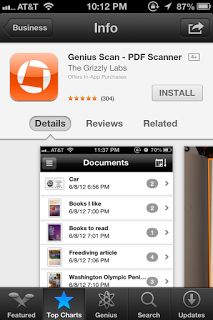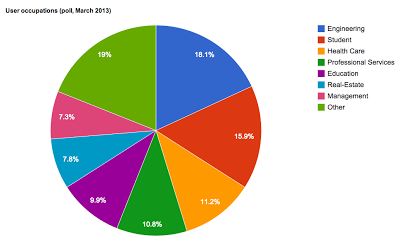From 0 to 100 million scans
On that day of June 2010, we nervously pulled the trigger and Genius Scan was live. Three years later, Genius Scan is reaching 10 million downloads and 100 million document scanned and still requiring very little maintenance.
Accidental start
The story of Genius Scan starts back in 2010 when I was supposed to fly back to France from Champaign, IL. Unfortunately, Eyjafjallajokull had decided otherwise. Stuck in Chicago and betting on a refund of my airfare, I bought a MacBook and started developing this app Guillaume and I had been discussing for a while in the air. |
| http://commons.wikimedia.org/wiki/File:Eyjafjallajokull-April-17.JPG |
Genius Scan was a simple tool that would let people scan photos from their phone and email them as PDF files. The cool central feature would be that it would detect the frame of the document, correct the perspective and apply black and white post-processing to enhance its legibility. Our only focus was speed (it had to be fast and we optimized the code and algorithm for that) and simplicity (it required the minimum number of steps from the user.)
Version 1.0 was released as a free app and shot up in the rankings. Our original goal was to turn it into a paid app soon after. However, as we did that and realized that we would lose our rankings, we decided that ranking high and getting lots of love from lots of users was better than making some money and reverted to a free app.
Growth
Monetization of the free app became natural as Apple launched iAd around that time. For those who remember, that was the summer when the eCPMs were sky-high. We only added a single banner at the bottom of one screen of Genius Scan as we hated apps that were full of advertisement and popups (it didn’t prevent all the ad networks of the planet to reach out to us) Later that year, we published a paid version of Genius Scan which supported exporting documents to the most popular cloud services such as Box, Dropbox, Evernote, Expensify and we kept the free app fully functional. Special shout out to Box and Expensify for being great partners!Growth since then has been organic. Paying to acquire users wouldn’t have made sense given the small amount of revenue per user. Genius Scan was featured several times and even awarded “#1 Top Free Business app” in 2010 by Apple.
75% of our users use Genius Scan for work. Some communities of small businesses such as healthcare, real-estate, law practices who rely a lot on paper and routine procedures are particularly fond of tools like Genius Scan that make their life easier. One of the most common ways people discover Genius Scan is by word of mouth.
Then, as we found time, we expanded to Android to look for more growth opportunities. While Android drives less profit than iOS, it’s definitely a non-negligible source of revenue.
We have now reached 10 million downloads. But what pleases us even more is how many of our users are active users. Genius Scan has now more than 1.2 million monthly active users and over the last 3 years, these users have scanned more than 100 million documents.
Operations
Dealing with so many users for a small 2-person team working on their free time requires some juggling and aggressive prioritization. One lesson is that not everything needs to be perfect at first. Looking back at Genius Scan 1.0, it had a fairly ugly UI, an even uglier icon and lots of limitations compared to the latest version but it didn’t prevent it from taking off (granted, standards have changed since 2010) but the basic structure was there. |
| Starting with a very very very simple UI |
But we took the time of adding more features when we had enough data points telling us that this would make the user experience better and only adding them when we knew we could get them right. We used three main channels to understand our user needs. Analytics services such as Flurry or Mixpanel allow you to understand what features users are using mainly and which path they take in the app. Analytics should be part of the first release and should be considered as a feature by developers. The second channel is user support. Aside from reflecting bugs, user questions are often very revealing of usability issues as you walk the user through to let them achieve their goal. Finally, we still display an ad in Genius Scan; it’s easy for us to setup a different banner to poll users to fill in a quick Google Docs survey. With more than 1 million active monthly users, it doesn’t take longer than a day to get hundreds of helpful responses and users do take the time to fill in free form fields.
We also strive to provide the best support possible, which means that we respond to all requests in a timely manner but we focused on improving the support workflow to alleviate this task. This is a topic by itself that we plan to address in a subsequent blog post.
 |
Great user support also translates in great reviews. |
The Future
Looking at the numbers and the user requests, the next steps seem obvious for Genius Scan. Currently, documents are only stored on the phone itself and can be individually exported to the cloud. We need to provide first class support for synchronization and back up of these millions of important documents which often times are crucial to users and small businesses.The Grizzly Labs is an ongoing collaboration between Guillaume and me, and we plan to keep experimenting with mobile apps that users can open knowing exactly what they will do for them and how they will be useful. More recently, we launched Genius Fax to make faxing as easy as possible from your iOS device (and it’s doing great) and Jotana, the first third-party Asana client for iOS.

